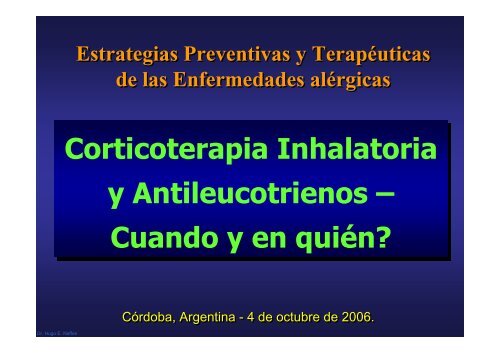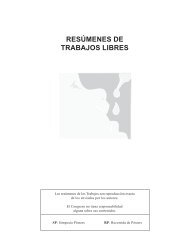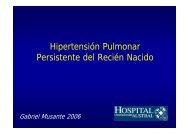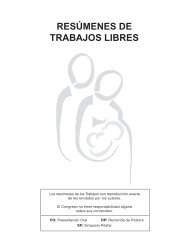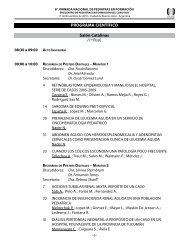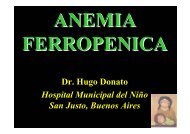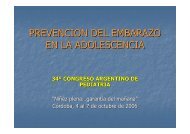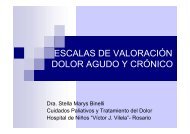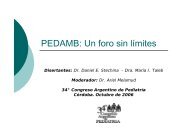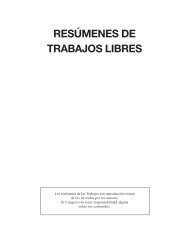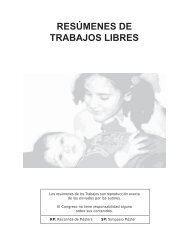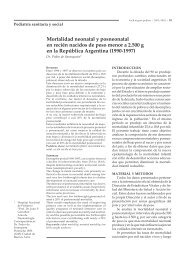Controladores
Controladores
Controladores
Create successful ePaper yourself
Turn your PDF publications into a flip-book with our unique Google optimized e-Paper software.
Estrategias Preventivas y Terapéuticas<br />
de las Enfermedades alérgicas<br />
Corticoterapia Inhalatoria<br />
y Antileucotrienos –<br />
Cuando y en quién?<br />
Dr. Hugo E. Neffen<br />
Córdoba, Argentina - 4 de octubre de 2006.
Provincia de Santa Fe<br />
Ministerio de Salud y Medio Ambiente<br />
Hospital de Niños<br />
Dr. Orlando Alassia<br />
Dr. Hugo E. Neffen<br />
Jefe Unidad de Medicina Respiratoria<br />
Santa Fe - Argentina
Objetivos del tratamiento del asma según la<br />
Iniciativa Global para el manejo del asma (GINA) (1)<br />
‘El objetivo del manejo del asma debiera ser el control de la<br />
enfermedad’<br />
●<br />
Mínimos síntomas crónicos (idealmente sin síntomas),<br />
incluyendo síntomas nocturnos.<br />
●<br />
●<br />
●<br />
Mínimos (infrecuentes) episodios.<br />
Sin visitas de emergencia.<br />
Mínimo uso de β 2 -agonistas de acción corta, de rescate.<br />
GINA, 2002
Objetivos del tratamiento del asma según la<br />
Iniciativa Global para el manejo del asma (GINA)<br />
‘El objetivo del manejo del asma debiera ser el control de la<br />
enfermedad’<br />
(2)<br />
●<br />
Sin limitaciones en actividades, incluyendo el ejercicio.<br />
● Variabilidad del Flujo espiratorio pico
Solo el 2.4 % de los pacientes<br />
alcanza el control segun GINA
Mejorando el manejo del asma<br />
Objetivos GINA<br />
Guías GINA publicadas<br />
Evaluación<br />
Resultados<br />
Opinión de expertos<br />
vs.<br />
MBE<br />
1995<br />
2003<br />
Implementación de<br />
las guías GINA
• Farmacocinética-dinamia<br />
• Eficacia clínica<br />
• Manejo Integral de las<br />
Vías Aéreas
FARMACODINAMIA<br />
FARMACO<br />
ORGANISMO<br />
FARMACOCINETICA
CELLULAR EFFECTS OF CORTICOSTEROIDS<br />
↓ Numbers<br />
(apoptosis)<br />
↓ Cytokines<br />
Inflammatory cells<br />
Eosinophil<br />
T-lymphocyte<br />
Structural cells<br />
Epithelial cell<br />
↓ Cytokines<br />
↓ Mediators<br />
Endothelial cell<br />
Mast cell<br />
CORTICOSTEROIDS<br />
↓ Leak<br />
↓ Numbers<br />
Airway smooth muscle<br />
↓ Cytokines<br />
Macrophage<br />
Mucus gland<br />
ß 2 -Receptors<br />
↓ Cytokines<br />
↓ Numbers<br />
Dendritic cell<br />
↓ Mucus<br />
secretion
Esteroides:<br />
Mecanismos de Acción<br />
Transactivación<br />
•Sintesis Receptores B-2<br />
•Efectos Metabolicos<br />
•Efectos adversos<br />
Transrepresión<br />
•Inhibición Sintesis de<br />
Factores de transcripción<br />
•Acciones antinflamatorias
Goals of Steroid Treatment in Asthma<br />
Steroid Responsiveness<br />
AP-1<br />
NF-κB<br />
STATs<br />
HAT = histone acetyltransferase<br />
mRNA<br />
CREB<br />
CBP<br />
Multiple<br />
transcription<br />
factors<br />
Histone<br />
acetylation<br />
HAT<br />
Ac<br />
Ac Ac<br />
Pol II<br />
Ac<br />
Ac Ac<br />
Repressive chromatin<br />
Decreased transcription<br />
Inflammatory gene repression<br />
Core<br />
Histones<br />
Active chromatin<br />
Increased transcription<br />
Inflammatory gene expression
EFFECT OF STEROIDS ON ß 2<br />
-ADRENOCEPTORS<br />
Corticosteroid<br />
ß 2 AR<br />
Glucocorticoid<br />
receptor<br />
Nucleus<br />
mRNA<br />
GRE<br />
GRE<br />
GRE<br />
ß 2 -Receptor gene
ß 2<br />
-Receptor mRNA (% change)<br />
EFFECT OF CORTICOSTEROIDS ON<br />
ß 2 -ADRENOCEPTORS IN HUMAN LUNG<br />
Human peripheral lung (n=6) Dexamethasone 1µM<br />
300<br />
200<br />
100<br />
0<br />
Northern blot<br />
p
EFFECT OF INHALED STEROID ON<br />
NUCLEAR LOCALISATION OF GR<br />
Control<br />
+ BDP<br />
N<br />
N<br />
Cy<br />
Cy<br />
Induced sputum: normal subjects<br />
% positive of total<br />
cells counted<br />
100<br />
80<br />
60<br />
40<br />
20<br />
Epithelial cells<br />
Inhaled BDP 800µg<br />
Nucleus<br />
Cytoplasm<br />
0<br />
0 min<br />
60 min
Medications for asthma can be administered<br />
via different ways, including inhaled, oral<br />
(ingested), and parenteral (subcutaneous,<br />
intramuscular, or intravenous). The major<br />
advantage of delivering drugs directly into<br />
the airways via inhalation is that high<br />
concentrations can be delivered more<br />
effectively to the airways, and systemic side<br />
effects are avoided or minimized.<br />
GINA Updated Oct’2005
Tratamiento del Asma con Corticoides<br />
Inhalados<br />
Efecto<br />
Efecto clínico<br />
Efecto adverso<br />
Dosis de la droga
The Fate of Inhaled<br />
Corticosteroids<br />
10% - 40%<br />
Deposited in lung<br />
Complete absorption<br />
from the lung<br />
Mouth and pharynx<br />
Lung<br />
Orally bioavailable<br />
fraction<br />
Systemic<br />
circulation<br />
Absorption<br />
from gut<br />
Liver<br />
60% - 90% Swallowed<br />
(reduced by spacer<br />
or mouth rinsing)<br />
GI tract<br />
First-pass<br />
inactivation<br />
Systemic<br />
side effects<br />
Adapted from Derendorf H. Respir Med. 1997;91(suppl A):22-28.
Bioactivation of Ciclesonide in the Lung<br />
Parent compound<br />
R-CIC<br />
HO<br />
CH 3<br />
O<br />
O<br />
O<br />
O<br />
H<br />
Esterases<br />
CH 3<br />
O<br />
O<br />
OH<br />
Active metabolite<br />
des-R-CIC<br />
HO<br />
CH 3<br />
CH 3<br />
O<br />
O<br />
O<br />
H<br />
O
Inflammatory Effects of Leukotrienes in the<br />
Airways<br />
Increased<br />
mucus secretion<br />
Decreased mucus<br />
transport<br />
Cationic proteins<br />
(Epithelial cell damage)<br />
Airway<br />
Epithelium<br />
Blood<br />
vessel<br />
Oedema<br />
Inflammatory Cells<br />
(e.g., Mast Cells,<br />
Eosinophils)<br />
CysLTs<br />
Eosinophil<br />
recruitment<br />
Increased release<br />
of tachykinins<br />
Smooth muscle<br />
Contraction and<br />
proliferation<br />
Sensory C<br />
fibres<br />
Adapted from Hay DW. Chest 1997;111:35S–45S.<br />
19
• Farmacocinética-dinamia<br />
• Eficacia clínica<br />
• Manejo Integral de las<br />
Vías Aéreas
Asthma / Wheezing in the First 6 yr. of Life<br />
N = 826<br />
Late onset (15%)<br />
Transient early (20 %)<br />
Never (52%)<br />
Persistent (13%)<br />
33 % wheeze < 3 yr<br />
3 6 years<br />
Martinez F, et al NEJM 1995<br />
Dr. Hugo E. Neffen
Childhood wheezing phenotypes<br />
Early viral wheezing<br />
How to predict persistent wheezers?<br />
Frequency<br />
?<br />
Atopic asthma<br />
Non-atopic wheezing<br />
1 2 3 4 5 6 7 8 9<br />
10<br />
Dr. Hugo E. Neffen<br />
years
INDICE PREDICTIVO DE<br />
ASMA*<br />
CRITERIOS MAYORES<br />
Asma en padres (MD).<br />
Dermatitis atópica (MD).<br />
Criterios menores<br />
Rinitis alérgica (MD).<br />
Sibilancias no<br />
relacionadas<br />
a resfrios comunes.<br />
Eosinofilia hemática<br />
(>4%).<br />
*Se define indice (+) cuando se reporta episodios recurrentes de sibilancias en el<br />
último año y 1 de 2 criterios mayores o 2 criterios menores.<br />
> ¾ partes de niños con indice (+) tienen asma activo entre 6 y 13 años.<br />
68% de los niños con indice (-) no tienen asma activo en edad escolar.<br />
Dr. Hugo E. Neffen<br />
Castro-Rodríguez J. A J Respir Crit Care Med 2000;162:1403
FÁRMACOS CONTROLADORES<br />
EFICACIA<br />
SEGURIDAD<br />
?<br />
ADHERENCIA<br />
COSTO-BENEFICIO
Alternativas Farmacológicas<br />
Rescatadores<br />
B2 agonistas de<br />
corta duración<br />
inhalados<br />
Anticolinérgicos<br />
inhalados<br />
<strong>Controladores</strong><br />
corticoides<br />
inhalados<br />
B2 agonistas de larga<br />
duración<br />
Cromonas inhaladas<br />
Anti-leucotrienos orales<br />
Teofilinas orales<br />
Corticosteroides orales
The CLIC Protocol<br />
Funded by NHLBI<br />
Characterizing the<br />
Response to a<br />
Leukotriene<br />
Receptor<br />
Antagonist and an<br />
Inhaled<br />
Corticosteroid
Persistent Asthma<br />
Long Term Controller Medication<br />
Leukotriene<br />
Receptor<br />
Antagonist?<br />
Inhaled<br />
Corticosteroid?<br />
Respond to:<br />
One<br />
Both<br />
Neither
Study Population<br />
• 144 children ages 6-17 years with mild-tomoderate<br />
persistent asthma<br />
– asthma symptoms or bronchodilator use: ≥3 days/week<br />
for previous 4 weeks<br />
– ≥ 12% FEV 1 reversibility to albuterol or<br />
methacholine PC20 ≤12.5 mg/mL<br />
– FEV1 of 70% of predicted value or greater<br />
• Medication restrictions:<br />
– No oral or inhaled CS therapy within 4 weeks<br />
– No leukotriene modifier agents within 2 weeks<br />
• No recent URI
Protocol Overview<br />
Assessment/<br />
Characterization<br />
Treatment Phase<br />
Followup<br />
Sequence 1:<br />
ICS<br />
LTRA<br />
Sequence 2:<br />
LTRA<br />
ICS<br />
Visit:<br />
Week:<br />
1<br />
-1<br />
2<br />
3<br />
0 2 4<br />
4<br />
8<br />
10<br />
5<br />
12<br />
6<br />
16<br />
7<br />
18<br />
Consent<br />
ENO<br />
FO<br />
MAXBD<br />
CBC<br />
ECP<br />
Chem<br />
IgE<br />
Gen<br />
ULT<br />
Preg<br />
DEPFM<br />
DD<br />
ENO<br />
FO/FEV 1 *<br />
Meth<br />
Skin<br />
ACQ/MAT<br />
AQ<br />
RD<br />
TC<br />
ENO<br />
FO/FEV 1<br />
ACQ/MATA<br />
Q<br />
RD<br />
ENO<br />
FO/FEV 1<br />
ACQ/MAT<br />
AQ<br />
RD<br />
TC<br />
ENO<br />
FO/FEV 1<br />
ACQ/MATA<br />
Q<br />
RD<br />
ENO<br />
FO/FEV 1<br />
ACQ/MATA<br />
Q<br />
RD<br />
Preg<br />
FEV 1<br />
RD<br />
Collect EPFM<br />
EXIT
Primary<br />
Outcome:<br />
FEV1<br />
Response<br />
Szefler S et al. JACI<br />
115:233, 2005
Primary<br />
Outcome:<br />
FEV1<br />
Response<br />
Szefler S et al. JACI<br />
115:233, 2005
Differential Response Analysis:<br />
FEV1 Response<br />
Greater response to fluticasone over montelukast<br />
was associated with baseline asthma features:<br />
• Higher bronchodilator use<br />
• Greater response to bronchodilator<br />
• Higher eNO<br />
• Higher serum eosinophilic cationic protein<br />
• Lower pre-BD FEV 1 % predicted<br />
• Lower pre-BD FEV 1 /FVC<br />
• Lower methacholine PC 20<br />
Szefler S et al. JACI 115:233, 2005
Differential Response Analysis:<br />
FEV1 Response<br />
Greater response to montelukast over fluticasone<br />
was associated with baseline asthma features:<br />
• Higher urinary leukotriene excretion<br />
• Younger age<br />
Szefler S et al. JACI 115:233, 2005
ICS or LTRA?<br />
(Szefler et al. J Allergy Clin Immunol 2005;115:233 2005)<br />
<br />
<br />
Response to FP alone was associated with:<br />
Higher levels of exhaled nitric oxide (>25 ppb)<br />
higher total eosinophil counts,(>350 cells/mm3 )<br />
ECP > 15mcg/ L<br />
higher levels of IgE ( >200 ku/l)<br />
lower levels of methacholine PC20<br />
lower pulmonary function<br />
Response to montelukast alone was associated with:<br />
Younger age (
Asthma-Free Days: Definition<br />
• No daytime or nighttime asthma<br />
symptoms,<br />
• No rescue albuterol for asthma symptoms<br />
• Peak flow ≥ 80% of personal best<br />
• No asthma health care use, and<br />
• No asthma-related absences from school<br />
or work<br />
Zeiger et al. JACI 117:45, 2006
Asthma-Free Days: Results<br />
• ACDs were significantly increased both by<br />
fluticasone (2.8 days/week [SE 0.23]) and<br />
montelukast (2.1 days/week [SE 0.23])<br />
• ACDs were significantly higher for<br />
fluticasone than for montelukast (P value<br />
for difference < .001)<br />
Zeiger et al. JACI 117:45, 2006
Individual Difference in<br />
Asthma-Free Days Response<br />
Zeiger et al. JACI 117:45, 2006
Individual Difference in<br />
Asthma-Free Days Response<br />
Zeiger et al. JACI 117:45, 2006<br />
Participants<br />
Better Response<br />
to Montelukast<br />
(n=15)<br />
Better Response to<br />
Fluticasone<br />
Propionate<br />
(n=36)<br />
-7<br />
-6<br />
-5<br />
-4<br />
-3<br />
-2<br />
-1<br />
0<br />
1<br />
2<br />
3<br />
4<br />
5<br />
6<br />
Difference in Asthma Free Days Response<br />
(Fluticasone Propionate – Montelukast)<br />
7
Differential Response Analysis:<br />
Asthma-Free Days<br />
Greater response to fluticasone over<br />
montelukast was associated with the following<br />
baseline asthma feature:<br />
• Higher eNO<br />
Zeiger et al. JACI 117:45, 2006
Summary and Conclusions<br />
• Childhood asthma is diverse<br />
– Genetics<br />
– Environmental<br />
– Lifestyle<br />
• Responses to medications are variable, and<br />
depend on outcome measured<br />
• Predictors of responses are beginning to be<br />
identified<br />
– Fluticasone – ↑eNO, ↑AHR, ↑Albuterol response, ↓PFT<br />
– Montelukast: young age and ↑LT excretion<br />
• Clinical experience is needed for validation
Dosis Diarias Comparativas Estimadas de<br />
Glucocorticoides Inhalados por Edad<br />
Droga<br />
Beclometasona-CFC<br />
42o 84 µg/puff<br />
Dosis Diaria Baja (µg) Dosis Diaria Media(µg) Dosis Diaria Alta(µg)<br />
> 5 y edad < 5 y > 5 y Edad < 5 y > 5 y Edad < 5 y<br />
168-504 84-336 504-840 336-672 > 840 > 672<br />
Beclometasona-HFA<br />
40o 80 µg/puff<br />
80-240 80-160<br />
240-480 160-320<br />
> 480 > 320<br />
Budesonida-DPI<br />
200 µg/inhalación<br />
200-600 200-400<br />
600-1200 400-800<br />
> 1200 > 800<br />
Budesonida-Neb<br />
Suspensión para<br />
Inhalación<br />
500<br />
1000<br />
2000<br />
Flunisolida<br />
250 µg/puff<br />
500-1000 500 -750<br />
1000-2000 1000-1250<br />
> 2000 > 1250<br />
Fluticasona<br />
MDI:44,110, 220 ug/puff<br />
DPI: 50,100,250<br />
µg/inhalación<br />
88-264 88-176<br />
264-660 176-440<br />
> 660 > 440<br />
Acetonida<br />
Triamcinolona 100<br />
µg/puff<br />
400-1000 400-800<br />
1000-2000 800-1200<br />
> 2000 > 1200
Growth During 1 Year of Treatment<br />
With Beclomethasone Dipropionate<br />
7<br />
6<br />
Mean Change in Height<br />
From Baseline (cm)<br />
5<br />
4<br />
3<br />
2<br />
1<br />
0<br />
*<br />
**<br />
BDP<br />
Placebo<br />
1 2 4 6 8 10 12<br />
Month<br />
**<br />
**<br />
**<br />
* P
7-11 years’ treatment with<br />
budesonide* * does not affect final<br />
Measured final height (cm)<br />
190<br />
180<br />
170<br />
160<br />
height<br />
Line of identity<br />
= female<br />
= male<br />
160 170 180 190<br />
*at minimum dose required to<br />
control asthma<br />
Predicted height (cm)<br />
Agertoft and Pedersen, AJRCCM 2000
Mean Change from Baseline in Stadiometry Height<br />
mITT population<br />
44
Viral Infection Is a Common Cause of<br />
Wheezing Exacerbations in Children<br />
<br />
In a survey, viruses were detected in up to 85% of<br />
wheezing exacerbations, in particular:<br />
– Rhinovirus<br />
– Coronavirus<br />
– Influenza virus<br />
– Parainfluenza viruses<br />
<br />
– Respiratory syncytial virus (RSV)<br />
Seasonal correlations between rates of upper<br />
respiratory infections (URIs) and hospital<br />
admissions for asthma<br />
Johnston SL et al. BMJ 1995;310:1225–1229; Johnston SL et al. Am J Respir Crit Care Med 1996;154:654–660;<br />
Pattemore PK et al. Clin Exp Allergy 1992;22:325–336.<br />
45
Montelukast Reduced Exacerbations from<br />
Autumn Through to Spring<br />
Patients<br />
with<br />
exacerbation<br />
episode<br />
(%)<br />
15<br />
10<br />
Montelukast 4 mg<br />
Placebo<br />
Winter Spring Summer Autumn<br />
5<br />
0<br />
JAN FEB MAR APR MAY JUN JUL AUG SEP OCT NOV DEC<br />
Month (in Northern Hemisphere)<br />
46
FACTORES RELACIONADOS CON EL<br />
INCUMPLIMIENTO DEL TRATAMIENTO<br />
Uso del Medicamento<br />
-Regímenes complicados<br />
-Dificultades con los inhaladores<br />
-Temor en relación a los efectos colaterales<br />
-Efectos colaterales<br />
-Costos<br />
Dr. Hugo E. Neffen
FACTORES RELACIONADOS CON EL<br />
INCUMPLIMIENTO DEL TRATAMIENTO<br />
Paciente / Médico<br />
-Carencia o incomprensión de información<br />
-Subestimación de la severidad<br />
-Actitudes en relación a la enfermedad/salud<br />
-Factores socioculturales<br />
-Deficiencia en la comunicación<br />
Dr. Hugo E. Neffen
DARLE EDUCACION AL PACIENTE
Control Vs. Severidad<br />
Optimo<br />
Manejo del Asma<br />
Insuficiente<br />
Severidad<br />
Leve<br />
Buen<br />
Control<br />
El Control<br />
refleja cuan<br />
adecuado es<br />
el<br />
tratamiento<br />
Severo<br />
La severidad<br />
es una<br />
propiedad de<br />
la<br />
enfermedad<br />
Pobre<br />
Control
Manejo del médico<br />
Severidad<br />
Automanejo<br />
Exposición a factores<br />
de riesgo<br />
CONTROL<br />
Estado de salud<br />
Costos<br />
Calidad de vida
Manejo del Asma:<br />
Opciones terapéuticas<br />
Algorritmo basado en el control de<br />
los síntomas s<br />
clínicos<br />
Fácil de usar y comprensible para el<br />
médico de atención n primaria y el paciente
Chapter 4: Asthma management and prevention<br />
program<br />
Component 3: Assess, Treat and Monitor Asthma<br />
<br />
<br />
<br />
Assessing Asthma Control<br />
Treating to Achieve Control<br />
Monitoring to Maintain Control
Simplified management approach based upon control
GINA guidelines update 2005<br />
Outcome: asthma control<br />
Outcome: best<br />
possible results<br />
Step 4<br />
Severe persistent<br />
Step 1<br />
Intermittent<br />
None<br />
Step 2<br />
Mild persistent<br />
Low-dose<br />
ICS<br />
(theophylline,<br />
leukotriene<br />
modifier,<br />
cromolyn)<br />
Step 3<br />
Moderate persistent<br />
Low-to-mediumdose<br />
ICS +<br />
LABA<br />
(theophylline,<br />
leukotriene<br />
modifier,<br />
oral β 2<br />
-agonist)<br />
• High-dose ICS +<br />
LABA<br />
plus if needed<br />
• Anti-IgE<br />
• Leukotriene<br />
modifier<br />
• Oral β 2<br />
-agonist<br />
• Oral corticosteroid<br />
• Theophylline-SR<br />
Adapted from GINA Workshop Report 2005
Unmet needs in the treatment of asthma<br />
intermittent<br />
mild moderate severe<br />
persistent<br />
safety<br />
efficacy<br />
high<br />
high<br />
low<br />
low<br />
treatment compliance low medium low ?
• Farmacocinética-dinamia<br />
• Eficacia clínica<br />
• Manejo Integral de las<br />
Vías Aéreas
Rinitis y Asma: Co-morbilidad<br />
* 40 % de los pacientes con Rinitis<br />
Alérgica presentan Asma Bronquial<br />
* 80 % de los pacientes con Asma<br />
Bronquial tienen Rinitis Alérgica
Esto llevó a hablar de:<br />
* United Airways (Vías Aéreas Unidas) (N. Mygind)<br />
* Una Vía Aérea, Una Enfermedad<br />
* Rinobronquitis Alérgica (F.E. Simmons)<br />
* Sindrome Alérgico Crónico de las Vías Aéreas<br />
* “La nariz es aquella parte de los pulmones<br />
accesible a los dedos” (L. Lichtenstein)
GUIAS DE ACTUACIÓN N EN<br />
RINITIS Y ASMA<br />
ARIA<br />
GINA
ARIA<br />
1- Por qué ARIA ?<br />
2- Nueva clasificación de rinitis<br />
3- Importancia de la inflamación nasal<br />
4- Tratamiento basado en la evidencia<br />
5- Impacto de las rinitis en el asma
ARIA Classification<br />
Intermittent<br />
. < 4 days per week<br />
. or < 4 weeks<br />
Persistent<br />
. ≥ 4 days per week<br />
. and ≥ 4 weeks<br />
Mild<br />
normal sleep<br />
& no impairment of daily<br />
activities, sport, leisure<br />
& normal work and<br />
school<br />
& no troublesome<br />
symptoms<br />
in untreated patients<br />
Moderate-severe<br />
one or more items<br />
. abnormal sleep<br />
. impairment of daily<br />
activities, sport,<br />
leisure<br />
. abnormal work and<br />
school<br />
. troublesome<br />
symptoms
Niveles de evidencia en el tratamiento<br />
de la rinitis alérgica - ARIA<br />
intervencion AR PAR<br />
adultosniños<br />
adultos niños<br />
anti-H1 orales A A A A<br />
anti-H1intranasales A A A A<br />
Corticoides intranasales A A A A<br />
cromonas intranasales A A A A<br />
anti-leukotrienos A A<br />
IT subcutánea A A A A<br />
IT sublingual / nasal A A A<br />
Evitación alergénica D D D D
Fármacos en rinitis alérgica<br />
ARIA<br />
estornudos rinorrea obstrucción prurito sintomas<br />
nasal nasal oculares<br />
H1-antihistaminicos<br />
orales +++ +++ 0 to + +++ ++<br />
intranasales ++ +++ + ++ 0<br />
intraoculares 0 0 0 0 +++<br />
Corticoides +++ +++ ++ ++ +<br />
Cromonas<br />
intranasales + + + + 0<br />
intraoculares 0 0 0 0 ++<br />
Descongestionantes<br />
intranasales 0 0 ++ 0 0<br />
orales 0 0 + 0 0<br />
Anti-colinergicos 0 +++ 0 0 0<br />
Anti-leukotrienos + ++ ++ ? ++
Tratamiento de la rinits alérgica<br />
(ARIA)<br />
Allergic Rhinitis and its Impact on Asthma<br />
Tratamiento basado en la evidencia<br />
Leve<br />
Intermitente<br />
Moderada<br />
Severa<br />
Intermitente<br />
Leve<br />
Persistente<br />
Corticosteroides Intra-nasales<br />
Cromona local<br />
Antihistamínico H1 no-sedativo, oral o local<br />
Descongestionante (< 10 días) oral o intranasal<br />
Evitación de alergenos e irritantes<br />
Moderada<br />
Severa<br />
Persistente<br />
Inmunoterapia
Farmacoterapia<br />
Seguridad<br />
Eficacia<br />
Facil administración<br />
Evitación<br />
alergénica<br />
Cuando sea<br />
posible<br />
COSTOS<br />
Educación de<br />
los pacientes<br />
Siempre indicado<br />
inmunoterapia<br />
Eficacia<br />
Puede alterar el el curso<br />
de de la la enfermedad
Recomendaciones de la guia<br />
ARIA<br />
1- En pacientes con rinitis persistente se debe<br />
evaluar la presencia de asma<br />
2- En pacientes con asma persistente se debe<br />
evaluar la presencia de rinitis<br />
3- Una estrategia segura y eficaz debe<br />
combinar el tratamiento de la vía aérea<br />
superior con la via aérea inferior
Manuel Vittori 2005<br />
Puente Colgante, Santa Fe – Argentina.
Automanejo<br />
Educación
Efectos clínicos de ICS en asma (1)<br />
● Mejora en la función pulmonar<br />
● Disminución de síntomas<br />
● Disminución de exacerbaciones<br />
● Disminución del uso de corticoides orales<br />
● Disminución del uso de β 2 -agonistas
Efectos clínicos de ICS en asma (2)<br />
● Mejora de HRB<br />
● Reducción de los espasmos bronquiales<br />
inducidos por alergenos<br />
● Reducción número de internaciones<br />
● Reducción de la tasa de mortalidad
Corticoides inhalados y<br />
riesgo de muerte por asma<br />
Suissa et al.
Asthma mortality, inhaled<br />
steroids, and charging<br />
asthma therapy in Argentina<br />
(1990-1999)<br />
Hugo Neffen, Carlos Baena-Cagnani, G. Passalacqua,<br />
et. al – Respiratory Medicine 2006.
Mortalidad por asma en Argentina 1990-1999<br />
Unidades + 000<br />
4<br />
3,5<br />
3<br />
2,5<br />
2<br />
1,5<br />
1<br />
0,5<br />
0<br />
GINA<br />
1990 1991 1992 1993 1994 1995 1996 1997 1998 1999<br />
1000<br />
800<br />
600<br />
400<br />
200<br />
0<br />
Global 5-34<br />
X = 2.58 X = 0.38<br />
Neffen H. ACTMA-ASTHMA Journal, 2001:2(1)38-39
Reducción del riesgo de muerte<br />
Cardiopatía<br />
isquémica:<br />
Aspirina<br />
Beta bloqueantes<br />
Estatinas<br />
Inhibidores ACE<br />
Clopidogrel<br />
ASMA:<br />
Corticoides Inhalados
Asthma<br />
Mortality in<br />
Argentina 2000 - 2004<br />
2,5<br />
2<br />
2,04<br />
1,5<br />
1,73<br />
1,89<br />
1,73<br />
1,71<br />
1<br />
0,5<br />
0<br />
0,2 0,26 0,24 0,21 0,22<br />
2000 2001 2002 2003 2004<br />
Global 5-34<br />
Dr. Hugo E. Neffen
Antiasmhatic Drugs Sales in Argentina<br />
(IMS) 2000-2004. (Unit + 000)<br />
2000<br />
2001<br />
2002<br />
2003<br />
2004<br />
Xanthines<br />
715<br />
669<br />
460<br />
481<br />
427<br />
S.A.BA.<br />
3249<br />
3125<br />
2569<br />
3100<br />
3200<br />
Inhaled cort.<br />
975<br />
957<br />
676<br />
800<br />
824<br />
S.A.BA +I. C<br />
643<br />
620<br />
499<br />
520<br />
550<br />
L.A.BA + I. C<br />
113<br />
174<br />
245<br />
409<br />
550<br />
Leukotriene<br />
modifiers<br />
93<br />
104<br />
63<br />
74<br />
90<br />
L.A.B.A.<br />
150<br />
13<br />
89<br />
73<br />
66
Ratio between (LABA+IC) vs. (SABA+IC) in Argentina (IMS)<br />
2000-2004<br />
100<br />
90<br />
80<br />
70<br />
60<br />
50<br />
85<br />
78<br />
67<br />
56<br />
50<br />
40<br />
30<br />
20<br />
10<br />
0<br />
44<br />
50<br />
33<br />
15<br />
22<br />
2000 2001 2002 2003 2004<br />
SABA+IC (Salbutamol + Beclometasone)<br />
LABA+IC (SM + Fluticasone / FM + Budesonide)
Guía Para el Manejo del Paso 3 de Asma<br />
Dosis Baja de Corticoides<br />
Inhalados (400 µg día o menos)<br />
Si no<br />
se controla:<br />
Dosis Alta<br />
de<br />
Corticoides<br />
Inhalados<br />
Agregar ß 2 -agonistas de LA<br />
(efectivo)<br />
Agregar dosis baja de teofilina<br />
(bajo costo)<br />
Agregar anti leucotrienos<br />
(- efectivo pero alto costo)
FÁRMACOS CONTROLADORES<br />
EFICACIA<br />
SEGURIDAD<br />
IC<br />
- β2<br />
ADHERENCIA<br />
COSTO-BENEFICIO
Table I. Estimates of the relative bioavailabilities of FP, MF,TA,<br />
BUD, BDP, and FLU when administered intranasally or orally<br />
Corticosteroid<br />
Intranasal Oral<br />
Fluticasone propionate


